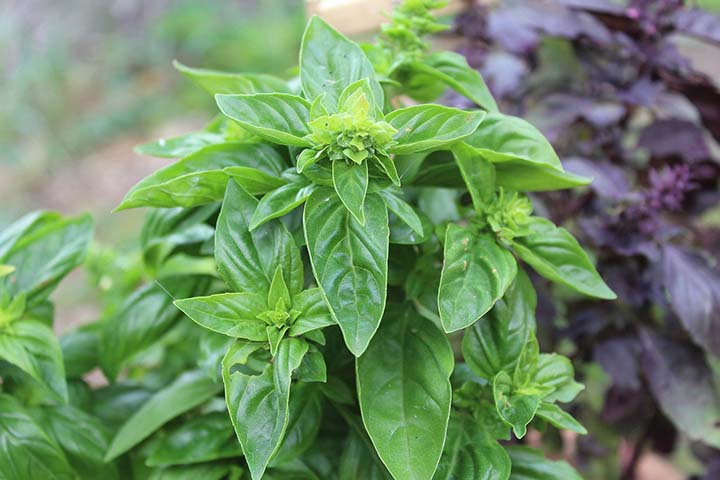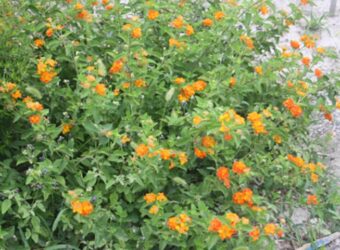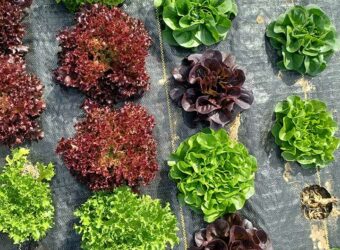Basil is a popular and attractive herb in cuisine around the world and has been used for centuries. It has many different varieties, each with its own unique flavor. Most basil leaves are green, but there are also purple basil, lemon basil, and even cinnamon basil!
Basil is easy to grow and can thrive indoors or outdoors, depending on your climate. Its fragrant aroma makes it ideal for adding robust flavors to soups, salads, sauces, and even desserts. Plus, basil can be used as an ornamental plant if you’re looking for something to add a little color to your garden.
One of my favorite ways to enjoy basil is to tuck it amongst my garden plants, where it does a fantastic job as a companion plant, improving the health and production of other garden plants nearby.
Let’s unpack a little about companion planting, why this aromatic herb is truly a gardener’s best friend, and how to best use it as a companion in your garden.
What is Companion Planting?
Companion planting is an ancient, time-tested, organic practice of gardening that uses beneficial interactions between plants to promote a healthy and productive garden. Here are just some of the many benefits of companion planting.
- Repel pests: Nothing is more devastating than having your tasty crops become dinner for pests. Cabbage worms, carrot flies, cucumber beetles, Mexican bean beetles, and cabbage moths are among the most damaging pests that take up residence in the home garden. Companion planting, when done correctly, provides an outstanding barrier against these and other pests, thus protecting your valuable crop from damage and destruction.
- Replenish soil nutrients: Crops require nutrients to grow and draw these nutrients out of the soil. Some companion plants such as bush or pole beans do a fantastic job putting nutrients back into the soil.
- Attract beneficial insects: All gardeners dream of a garden patch overflowing with pollinators like bees and ladybugs, but sometimes, they seem hard to find. Tucking companion plants into your veggie patch can help to draw these very important insects to your crops.
- Improve taste and accelerate plant growth: Some companion plants, including basil, chamomile, summer savory, and marjoram, releases chemicals that hasten nearby vegetable growth and even improve vegetable flavor.
- Provide shade: Taller plants and those with busy leaves such as zucchini and asparagus, serve as a living shade tarp for sun-sensitive plants below them.
- Keep the soil cool: Low-growing and spreading companion plants like oregano help to keep the soil cool and even retain moisture.
- Keep weeds away: One of the most significant benefits of planting close together is that tweeds will have little room to sprout up and compete for nutrients.
How to Companion Plant?
Whether you are gardening in the ground, in a raised bed, or containers, companion planting is all proximity – plants must be close to each other. After all, companion plants are friends; they get along and benefit each other, meaning they don’t mind being planted close together.
The key to companion planting is to do your research first to determine which plants enjoy each other’s company. Knowing who gets along is essential for companion planting success. Once you have determined key players in your garden, research the best companion plants and make some room in your garden plans to accommodate them.
I suggest a quick garden bed drawing with the names of all the plants you wish to include. This helps keep you organized and will also be helpful if you plant from seed.
Tips for Companion Planting
Here are a few general tips to help you have success with companion planting.
- Plant tall crops on the north side of the garden and low-growing crops on the south side to ensure that all plants get enough sunlight.
- Plant root vegetables, such as potatoes and carrots, near fast-growing vegetables like beans or peas to make the most of limited space.
- Plant herbs and flowers with vegetables to help deter pests in your garden. For example, planting marigolds near tomatoes helps to repel aphids.
- Plant plants with similar nutrient needs together, such as cabbage and beets, which both need lots of nitrogen.
- Make sure you know which plants don’t get along before planting them near each other, like tomatoes and potatoes, which weaken each other’s growth.
- Plant companion plants in clusters to enhance their beneficial effects, such as planting different herbs and flowers together to attract pollinators and beneficial predators.
- When you companion plant, the most important thing to remember is what the mature size of each of your plants will be. Make sure your plants have enough space between them so they can flourish without crowding each other out for resources. This will ensure that your plants can still get along and benefit each other.
Using Basil as a Companion Plant
I love using basil for companion planting in my gardens because I know that when I’m done harvesting, I have a beautiful backdrop of herbs to keep things fresh and lively all season long. Plus, who can avoid the tempting aroma of basil and the opportunity to use it in so many ways in your favorite dinner delights?
To use basil as a companion plant, it is essential to know just who its friends are.
Basil is an excellent companion to the following plants:
Tomatoes
Have you ever had a beautiful crop of tomatoes destroyed by hornworms? If so, you know just how devastating this can be. One of the best reasons to plant basil nearby your tomato plants is to keep these pesky critters away. My tomatoes also grow faster and taste better when basil is used as a companion plant.
Potatoes
Planting basil close to potatoes helps bring forth a healthy and plentiful potato harvest and improves potatoes’ taste.
Asparagus
When basil and asparagus are planted together, they become a powerful ladybug attractor. In addition, basil repels the asparagus beetle, which loves to munch on tender young asparagus shoots.
Garlic
Basil and garlic are close friends that improve each other’s flavor when planted near each other.
Peppers
I always put a few basil plants close by to peppers to not only keep pests away but also to help trap the moisture and humidity that peppers love.
Root Vegetables
Beet, carrot, radish, turnip, and parsnip greens are well protected from damaging pests when basil is nearby.
Marigolds
Basil and marigolds are more than just friends; they are a dynamic duo that does double duty keeping pests away from the garden. Their combined aroma is just simply too powerful for any pests to risk it.
Borage
This beautiful flowering herb with blue star-shaped blossoms draws pollinators and repels bests while improving the flavor and growth of basil.
Chives, Oregano, and Chamomile
These pretty flowering herbs love to be near basil plants which help to increase the potency of their essential oils.
In return for being such a good friend to popular garden favorites, basil benefits from the protection provided by its neighboring veggies against wind damage
What Not to Plant Alongside Basil?
Basil doesn’t want to be friends with everyone, though – certain plants should not be planted alongside it. These include cabbage and related vegetables, parsley, rosemary, rue, and sage, which compete for nutrients and light. Also, don’t plant fennel and basil together because fennel with stunt basil plant growth.
In addition, planting basil too close to cucumbers, which consist primarily of water, will cause their flavor to become less intense and can stunt growth.
Tips for Caring for Basil Plants
When it comes to caring for your basil plants, you should keep a few things in mind. First, water regularly but not too much; this will help keep the soil moist without overwatering and causing fungal diseases.
Regular pruning is also essential as this helps promote new growth while controlling the size of the plant. Lastly, ensure the soil has adequate drainage, so the roots don’t become waterlogged and soggy.
With a bit of care and attention, you can have thriving basil plants that will last all season long and serve as excellent companions for many of your garden favorites.
Takeaway
Let’s recap. When done correctly, companion planting can provide a host of benefits like improved soil quality, increased crop yields, pest control, and more.
And adding basil into the mix is an ideal way to ensure your garden thrives! Just remember what not to plant with it to keep your plants happy and healthy all season long.






